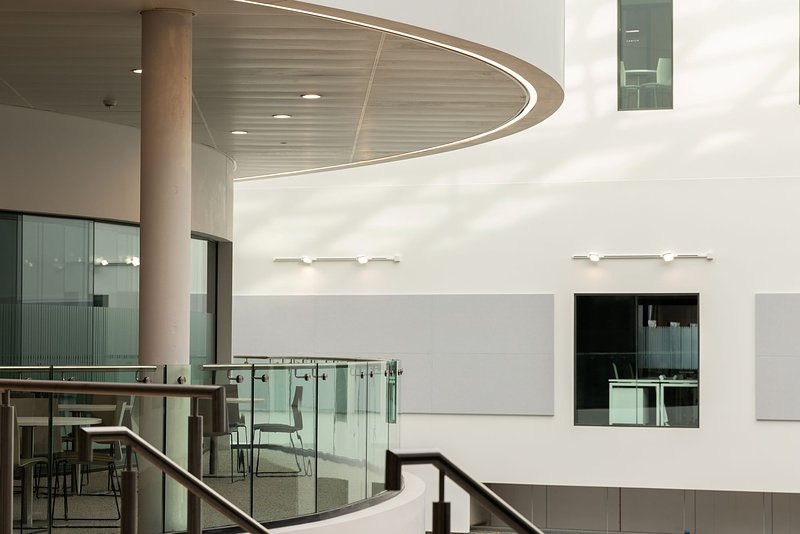Leviat Supports University's First Net-Zero in Operation Building
Strategically located in the heart of the University’s Social Sciences campus, this award-winning 17,000m² building brings together five of the faculty’s departments under a single roof, and provides a range of world-class teaching, research, scientific and social facilities for use by students and staff across the faculty, as well as the local community.
Referred to as ‘The Wave’ for its flowing lines, rhythmic design and striking glazed façade, it is the University’s first net-zero in operation building. Designed by Sheffield-based HLM Architects, the unique building achieved the coveted BREEAM Outstanding Design Stage certificate - further supporting the University’s mission towards sustainability in both architecture and operation.



The Challenge
To achieve the unique design features and tight construction deadline for this architecturally ambitious project, the high-profile building was designed around a post-tensioned concrete frame. Unexpected early setbacks in ground engineering delayed the project, putting pressure on concrete frame contractor, Moortown, and post-tensioning contractor, CCL, to complete the final structural frame safely, and in the shortest possible time.
This meant addressing key issues including reinforcement continuity at concrete slab joints, post tensioning of slabs and how to avoid punching shear at column heads. In each case, traditional solutions can be labour-intensive, slowing down the build process, and preventing early access for follow-on trades.
The Solution
Leviat worked closely with CCL and Moortown to provide a complete package of standard and bespoke solutions based on the market leading range of Ancon structural connections, to help keep the project on schedule.
Eazistrip made short work of slab joints
Since the lift cores were the first elements completed, reinforcement continuity at core/slab junctions was a priority. Normally involving extensive core/shuttering drilling and rebar configurations, this was achieved using Ancon Eazistrip, a galvanised steel box housing pre-bent bars. Once cast into the slab edge, the bars are simply straightened, ready for lapping onto the main reinforcement - a much safer and quicker solution.
Ancon Eazistrip Reinforcement Continuity Systems (PDF, 5.06 MB)
Post tensioning solution avoided 30-day “Pour Strip” scenario
To speed up and simplify post tensioning of concrete slabs, the Leviat team worked with CCL to utilise an alternative solution for slab-to-slab temporary movement joints, using Ancon Lockable Dowels in place of traditional end anchorages and pour strips. This avoided the usual 1-metre-wide pour strip and 30-day delay prior to closure, providing fewer trip hazards and a safer site environment, as well as dramatically reducing overall construction time by allowing follow-on trades unhindered access to the slabs.
Ancon Lockable Dowels (PDF, 2.34 MB)
Free software enabled shear calculations to be completed quickly
Finally, the team addressed the issue of punching shear at columns heads. Preventing punch-through due to high slab weight is traditionally achieved using a complex configuration of shear links, but this is labour intensive, and requires individual calculations to determine the shear forces involved – with every column being different.
The solution was to use Ancon Shearfix, a fully bespoke stud rail system which is individually designed using free Leviat software to suit each column, and is installed in a fraction of the time of the traditional ‘Shear Link’ alternative. Leviat worked with CCL to provide the bespoke stud rails with a short lead-in and delivery time, enabling them to install slab tendons quickly and start pouring early. As a bonus, the free Leviat software was able to complete the shear calculations for all or the columns quickly, further reducing delays.
Ancon Shearfix Punching Shear Reinforcement (PDF, 6.08 MB)

Leviat’s solutions were used for fixing and support throughout the building, enabling the concrete frame to be completed to meet the compressed site program.
Leviat’s technical teams worked closely with the contractors throughout the design and installation phases, providing on- and off-site support and advice as required, to ensure that the various systems could be installed efficiently and quickly with minimal delays.
Moortown’s site manager was extremely pleased with Leviat’s bespoke solutions:“We have worked with Leviat on many similar projects in the past, so we knew we could rely on them to provide the solutions we needed”“With ongoing support from their technical teams, we were able to complete the structural framework early, enabling internal finishing work to begin immediately.” |
|---|

